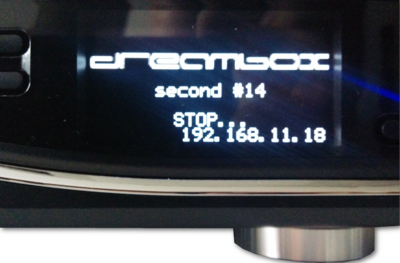Bios DM7080HD
Version vom 30. November 2014, 13:52 Uhr von Mfgeg (Diskussion | Beiträge)
Andres als von anderen Boxen gewohnt, erreicht man das Bios via seriellem Kabel. Das Bios wird vom Broadcom entwickelten CFE (kurz für Common Firmware Environment) Bootloader bereitgestellt. Die Interaktion erfolgt durch eine grafische Oberfläche, oder durch Eingaben via Kommandozeile (CLI).
Inhaltsverzeichnis
Voraussetzungen
Die Voraussetzungen für den Zugriff sind wie folgt:
- Programm für serielle Kommunikation (z.B. PuTTY)
- USB ↔ Mini USB Kabel
- Installierter USB / UART Treiber unter Windows
Serielle Verbindung herstellen
- Serielle Verbindung zur Box herstellen z.B. via PuTTY.
- Dreambox einschalten und gleichzeitig die Taste ↑ gedrückt halten.
- Das BIOS sollte nach einigen Sekunden automatisch erscheinen.
CLI Modus
Die folgende Ausgabe zeigt das starten der Dreambox in den BIOS / CFE Modus.
Dreambox DM7080 M0 M1 SHMOO 0 00000000 1 00000000 C do_boot . load 2nd stage SL2=1 LLMB=0000C000 BP=02000000 L2Cfg=1E76C637 L2Buf=44707700 BrCfg=F01C204F BrMod=02800001 BrZp0=05000000 BrZp1=00002000 #@ BCM97434B0 CFE v3.15, Endian Mode: Little Build Date: 20140202 (dm@dm) Copyright (C) Broadcom Corporation. Initializing eMMC (v0.9). 2013.03.21 : 1 ---> device is Sector mode eMMC (1th scan) GenCmd6Timeout 250 [eMMC Partition Information] : ReadBlkLen(512B) Partition : Physical, Logical - Data : 003776MB, 003776MB, Physical_SectorCount(7733248, 0x00760000)! - ENH Data: 000000MB, Address(0x000000000000)! - Boot1 : 000002MB, 000640KB + 256KB for BSEK reload! - Boot2 : 000002MB, 000640KB + 256KB for BSEK reload! fp: init done MACRONIX SPI flash detected: Size = 16MB, Sector Size 4096, Page Size 256 found card in unknown state ca valid! CPU speed: 1407MHz DDR Frequency: 667 MHz DDR Mode: DDR3 Total memory(MEMC 0): 1024MB MEMC 0 DDR Width: 32 Total memory(MEMC 1): 1024MB MEMC 1 DDR Width: 32 Initializing USB. USB: Locating Class 09 Vendor 0000 Product 0000: USB Root Hub USB: Locating Class 09 Vendor 0000 Product 0000: USB Root Hub USB: Locating Class 09 Vendor 0000 Product 0000: USB Root Hub DM init finalization yxml: processing file of 131072 bytes... succeeded! no file loaded, create xml restoring default xml loaded network params of: DHCP, 192.168.0.219, 255.255.255.0, 192.168.0.1 [1] type 1, dev eth0, loader elf, filesys tftp, file 192.168.223.199:/vmlinuz, options root=/dev/nfs rw nfsroot=192.168.223.199:/nfsroot/dm7080hd bmem=512M@512M ip=192.168.223.189 5 [2] type 2, dev emmcflash0.fastbt0, loader elf, filesys raw, file , options [3] type 2, dev emmcflash0.fastbt1, loader elf, filesys raw, file , options added 3 sources to autoboot list CFE initialized. Starting splash screen. No valid image found in flash0.splash - disabling splash ***** DREAMBOX SSBL ***** Not interrupted yet, trying autoboot, hit any key in the next 500ms to cancel Proceeding with autoboot.. You can try aborting with Ctrl+C *** Autoboot: Trying device 'eth0' file 192.168.223.199:/vmlinuz (eth0,tftp) 1000 Mbps Full-Duplex DHCP done Device eth0: hwaddr 00-09-34-2A-0D-D7, ipaddr 192.168.11.18, mask 255.255.255.0 gateway 192.168.11.1, nameserver 192.168.11.1 Loader:elf Filesys:tftp Dev:eth0 File:192.168.223.199:/vmlinuz Options:root=/dev/nfs rw nfsroot=192.168.223.199:/nfsroot/dm7080hd bmem=512M@512M ip=192.168.223.189 5 Loading: Failed. *** Autoboot: Trying device 'emmcflash0.fastbt0' file (emmcflash0.fastbt0,raw) Loader:elf Filesys:raw Dev:emmcflash0.fastbt0 File: Options: Loading: Failed. *** Autoboot: Trying device 'emmcflash0.fastbt1' file (emmcflash0.fastbt1,raw) Loader:elf Filesys:raw Dev:emmcflash0.fastbt1 File: Options: Loading: Failed. *** Autoboot failed/stopped. Autoboot cancelled, starting config utility Initializing the network, this may take a few seconds.. 1000 Mbps Full-Duplex network is up, set ip DHCP... DHCP done
CLI Hilfe
Habt ihr die grafische Oberfläche beendet über den Menüpunkt Exit → Abort, dann zeigt der folgenden Befehl alle Kommandozeilen - Möglichkeiten an:
helpBIOS starten
Der folgende Befehl startet das BIOS von der Kommandozeile.
menu




